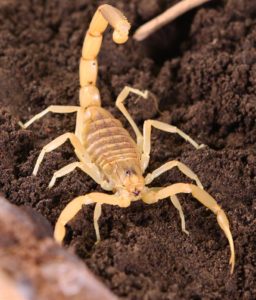Important facts about this five-striped smooth-tail creature also known to be the “Death stalker“.
Scorpions get a bad rap for being dangerous. After all, there are over 1,700 known species, and less than three dozen have venom that’s dangerous to humans. Of course, those less than three dozen have made quite an impact on society considering the widespread notion that scorpions are all lethal. One such scorpion species is the Deathstalker scorpion, a species endemic to desert areas in North Africa and the Middle East.
STALKING SOME FACTS:
• Scientific Name: Leiurus quinquestriatus
• Known subspecies: L. quinquestriatus hebraeus, L. quinquestriatus quinquestriatus
• Kingdom: Animalia
• Phylum: Arthropoda
• Subphylum: Chelicerata
• Class: Arachnida
• Order: Scorpiones
• Family: Buthidae
• The scientific name roughly translates into “five-striped smooth-tail.”
• Habitats: deserts, scrublands
• Found in: North Africa, Middle East
• Also known as: Israeli Yellow Scorpion, Omdurman Scorpion, Naqab Desert Scorpion
THE YELLOW PERIL – Known by a variety of other names depending on location—Israeli Yellow Scorpion, Omdurman Scorpion, Naqab Desert Scorpion, among others—the Deathstalkers average 3.5 to 4.5 inches in length. They are usually straw yellow, though this can slightly vary as an adaptation to their environment, which is generally in the dry climate of their typical habitats.
Unlike most other scorpion species with thick and stalky limbs, Deathstalkers have thin and lanky appendages but large pincers. Their pincers are also not very powerful despite the size.
Their poisonous stingers are a different matter entirely. Deathstalkers are not so named because they’re cuddly little creatures; they are considered one of the deadliest scorpions. Because of their relatively weak pincers, the Deathstalkers need to administer a powerful poison immediately upon capturing their prey to ensure these do not escape from their clutches.
Their venom—a stew of neurotoxins that include chlorotoxin, charybdotoxin, scyalltoxin, and agitoxins—can quickly kill their typical prey of crickets, spiders, centipedes, earthworms, and even other scorpions. This same venom is also extremely painful for healthy adult humans, although it is not necessarily lethal, especially with immediate and proper medical care. However, fatalities still do occur—especially for young children, older folks, and less healthy people—usually from heart and respiratory failure.
RISKY BUSINESS – Despite the inherent risks associated with Deathstalkers, a number of daredevil hobbyists around the world still enjoy working with them.

There are two kinds typically raised by hobbyists: the general Leiurus quinquestriatus (LQ) and what is known as Leiurus quinquestriatus deserti (LQD) in the community, although the latter does not truly exist as a scientifically-designated subspecies. The LQ, which is light yellow, is a little more difficult to acquire, while the darker and medium-sized LQD are easier to obtain.
Animal Scene’s resource Pitlair explained that in order to safely care for them, scorplings should be housed in thick deli containers (they can sting through the thinner ones) with sand for its substrate, misted weekly through the sides of the enclosure, with a small “hide” where they can cool down and take a rest. They also feed once a week.
He advised that sub-adults and adults should to be housed in medium to large Critter Keepers with a substrate composed of fine sand and cocopeat. Hides positioned sideways will also enable the owner to be aware of where they are at all times. A live cactus inside the enclosure is also advantageous; mist this weekly, and one can observe the Deathstalker drinking water droplets from the plant.
An active Deathstalker is a healthy Deathstalker, he says; there’s nothing cute about one that is obese and slow.
SOME LIKE IT HOT – Pitlair adds that it’s a challenge to keep these creatures under desert conditions, particularly if one lives in a tropical or temperate climate. This is particularly crucial during the pre-molt stage, where the proper temperature is important to help them through the molting process. He recommends sticking a thermometer in the substrate to determine that the appropriate temperature level has been achieved, but of course, one must exhibit extreme caution to avoid getting stung. (Using plastic—not metal—tongs to place the thermometer in the substrate and to retrieve it later may be a good idea; just make sure not to use those tongs for any other use!)
In order to see these creatures grow, many hobbyists purchase inverts as slings to help them observe the growth process. Acquiring LQs and LQDs in the second instar (developmental stage between moltings) is definitely more challenging than getting one in the sixth or seventh instar, but at the same time many hobbyists find the process more rewarding, not to mention more affordable. Others, however, still do opt to acquire adults.

Though they look cute because of their size and color, Pitlair reminds us that Deathstalkers are pets to be admired and cared for but not toyed with. Touching or petting them is never a good idea, and unlike cats or dogs, they will not show affection. Quite the contrary, they are particularly aggressive and take no prisoners. This is especially important to remember when one has kids at home; keep them away from the enclosures and also educate them on the dangers of the scorpions.
Keeping these in mind will ensure that one will be able to safely care for and enjoy the company of these glorious yet deadly creatures of the sand.
STINGER OR PINCER?
Scorpions have two weapons at their disposal: the claw-like pincers or the venomous stingers at the end of their tail. Due to variations in size and shapes of these weapons, their defense mechanism tends to differ. They tend to use the implement that is bigger, so if you are in the habit of annoying scorpions but are too afraid of getting stung by those poisonous tails, try to irritate those species with bigger pincers. Or maybe not.
SOURCES:
• http://www.scorpionworlds.com/facts-about-scorpions/
• http://www.nyp.org/deathstalkerscorpion/scorpion_facts.html
• https://askabiologist.asu.edu/venom/scorpion_venom
•https://bioweb.uwlax.edu/bio203/s2014/obrien_kev2/interactions.htm
•http://www.isciencetimes.com/articles/6313/20131113/scorpions-stingers-pincers-attack-defense-predators.htm
• http://arachnoboards.com/threads/leiurus-quinquestriatus-v-leiurus-deserti.219337/
• http://www.scorpionworlds.com/deathstalker-scorpion/
Photos by Jeffrey Lim
This story appeared as “Queen of the Desert” in Animal Scene’s July 2016 issue.






